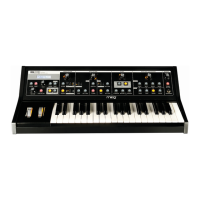Page 14
LP User’s Manual - The Components
Page 15
LP User’s Manual - The Components
Finally, the OVERLOAD parameter allows you to set the amount of signal clipping from none to soft to
hard clipping as the amount is increased. The results you get with OVERLOAD will depend on the set-
tings of the oscillator waves and levels, and the lter cutoff and the lter resonance settings in addition to
Overload amount. Overload is not the same distortion you’d get from a fuzz box. It can an be quite subtly
applied to add just a touch of ‘bite’, or aggressively applied to add a jaggy edginess to the sound.
Filter Section controls:
Cutoff:
When the CUTOFF switch is selected, the analog edit control is used to adjust the lter cutoff frequency.
The cutoff frequency is adjustable from about 20 Hz to 16 Khz. As the edit control is rotated clockwise, the
cutoff frequency is increased, allowing more of the signal harmonics to pass through the lter.
Resonance:
When the RESONANCE switch is selected, the analog edit control is used to adjust the lter resonance.
Resonance causes feedback in the lter circuit, adding harmonic emphasis at the cutoff frequency. When the
Resonance control is all the way down, the lowpass lter acts basically as a tone control, rolling off the high
end of the signal as the Cutoff control is turned down. As Resonance is increased, the lter begins to form a
peak at the cutoff frequency. This emphasizes harmonics near the cutoff frequency, and can result in a ‘wah-
wah’ effect when resonance is set fairly high and the lter cutoff is varied. As the resonance is turned up the
peak increases in strength until it begins to self-oscillate – creating a sine wave with the same frequency as
the cutoff frequency.
Keyboard Control Amount (KB AMOUNT):
When the KB AMOUNT switch is selected, the analog edit control is used to adjust the amount of post-
glide keyboard voltage that is routed to the lter cutoff frequency. When the edit control is rotated fully
clockwise, the lter cutoff follows the key played on the keyboard. A higher key will cause a higher cutoff
frequency. This allows a sound to retain its brightness as it is played higher on the keyboard.
Envelope Generator Amount (EG AMOUNT):
When the EG AMOUNT switch is selected, the analog edit control adjusts the amount of the Filter Enve-
lope Generator output that affects the lter cutoff. The EG Amount is bi-polar, as indicated on the panel so
the amount is 0 when the edit control dial is at the 12 o’clock position. Rotating the control CW from that
point adds a positive EG amount to the lter cutoff, while rotating the control CCW from that point adds a
negative amount to the lter cutoff.
Overload:
When the OVERLOAD switch is selected, the analog edit control adjusts the amount of pre-lter and post-
lter clipping. Overload can be used to warm up sounds and give them a distinctive tonal edge. Advancing
the edit control increases the amount of clipping from the subtle warmth of soft clipping to the ‘growl’ pro-
vided by the beginnings of hard clipping. When set to 100%, Overload adds a volume boost of about +6dB.
Additional CV control:
The FILTER jack on the side-panel is a CV input for external control of the lter cutoff parameter. The jack
accepts -5 to +5 volts, or an expression pedal like the EP-1. A voltage applied to this jack is added to the
setting of the lter cutoff control. A one-volt change in the control voltage will change the cutoff frequency
of the lter by about one octave.

